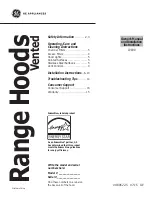
5
B. Connecting the Green Appliance Wire to
the Neutral (White) Supply Wire – Where
Local Codes Permit
1. Connect the green and white appliance
wires to the neutral (white) supply wire in
the junction box.
2. Connect the black appliance wire to the
black (L1) power supply wire in the junction
box.
3. Connect the red appliance wire to the red
(L2) power supply wire in the junction box.
C. Connecting the Green Appliance Wire to
a Grounded Supply Wire or a Grounded
Cold Water Pipe – Where Local Codes
Permit.
1. Separate the green and white appliance
wires.
2. Connect the white appliance wire to the
neutral (white) supply wire in the junction
box.
3. Connect the black appliance wire to the
black (L1) power supply wire in the junction
box.
4. Connect the red appliance wire to the red
(L2) power supply wire in the junction box.
5. Connect the green appliance wire to a
grounded supply wire in the junction box or
to a grounded cold water pipe.
6. If connecting to a grounded cold water
pipe, a separate copper grounding wire
(No. 10 minimum) must be connected to a
grounded cold water pipe by means of a
clamp and then to an external grounding
connector screw.
Conduit from
appliance
Cable from
power supply
Wire nut
(3 places)
Junction
box
RED
RED
GREEN
WHITE
WHITE
BLACK
BLACK
**Connecting the appliance to a
three-wire power supply
Conduit from
appliance
Cable from
power supply
Wire nut
(4 places)
Junction
box
RED
RED
GREEN
GREEN
WHITE
WHITE
BLACK
BLACK
Separate No. 10 (minimum)
copper grounding wire
Clamp must be
tight on pipe
No. 4
copper wire
Metal
water pipe
Clamps
Bare metal
Meter
Connecting the appliance ground to a grounded junction box wire or grounded cold water pipe
Gas Connection
Before sliding the range into the cabinet,
connect a flexible gas connector to the gas
shut-off valve previously installed on the stub
out. The gas valve must be turned off during
installation. Connect the flex connector to the
pipe fitting at the right rear of the range.
WARNINGS:
1. Do not apply excessive
pressure when tightening gas
connections and fittings.
2. Do not use teflon tape or
plumber’s putty on gas flex
line connections.
3. Turn all cooktop control valves
to the “OFF” position. Turn
on gas supply and check all
lines and connections for
leaks using a soap and water
solution. Do not use a flame to
check for leaks. After verifying
that there are no gas leaks,
turn off the gas supply to
the range by turning the gas
shut-off valve to the “OFF”
position.
4. For LP installations, the LP
gas tank must have its own
high pressure regulator. This
is in addition to the pressure
regulator provided with the
range.
5. The maximum gas supply
pressure to the regulator must
never exceed 1/2 pound per
square inch.
NOTE:
The gas pressure regulator is
pre-set at the factory for the
type of gas intended for use
with the appliance. Verify that
the appliance is compatible with
the type of gas available by
checking the data plate located
behind the inlet air cooling grill.
Ranges intended for use with LP
gases will have “LP” as a part
of the model number. Consult
your dealer if the range is not
compatible with your gas supply.
Installing the Range
Measure from the floor to the countertop and
adjust the leveling legs as required to position
the top frame at the desired height, based on
the cabinet and countertop installation. Carefully
slide the range into position in the cutout. The
left rear leveling leg should engage the anti-tip
bracket.)
When the range is to be installed as a “slide-in,
self rimming” (with the range top overhanging
the countertop cutout), measure from the floor
to the countertop. Adjust the leveling legs to
position the bottom edge of the range top
frame approximately 1/8” above the level of the
countertop. This will allow the range to slide
over the countertop. Carefully slide the range
into position in the cutout. The left rear leveling
leg should engage the anti-tip bracket. To lower
the range onto the countertop, turn the leveling
legs counterclockwise. Lower the range until
the bottom of the range top just contacts the
countertop. Do not allow the full weight of the
range to hang on the counter.
Installing the Burner Components
Remove the brass burner rings, porcelain burner
caps, and porcelain gates from their shipping
packages. Place each burner ring onto its
corresponding burner base, being certain that
the five alignment tabs slide into the matching
notches in the base. Set each porcelain burner
cap on top of its corresponding burner ring.
Place oven exhaust cover over the opening in
the center of the top frame. Place each grate
onto the top frame, being certain that the rubber
feet are positioned in the locating dimples.
WARNING:
Never attempt to operate the
cooktop section of the range with
any of the burner rings, burner
caps or grates removed.
NOTE:
Prior to operating the cooktop or
oven sections of the range, please
read the accompanying Use and
Care Manual carefully. Important
safety, service and warranty
information is contained within
this manual.
Re-installing the Oven Door(s)
Grasp the oven door on opposite sides and
lift it until the door hinges are aligned with the
openings in the oven frame. Holding the door at
about a 30˚ angle from the horizontal, slide the
hinges into the openings until the bottom hinge
arms drop fully into the hinge receptacles. Lower
the door to the fully opened position, and then
rotate the two hinge catches toward the oven.
Open and close the door completely to ensure
that it is properly installed. Peel off the protective
layer of plastic that covers the door panel.


























